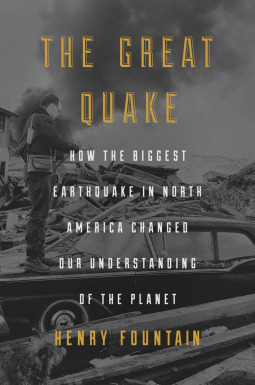The thirty-second book I read in 2018 was The Great Quake: How the Biggest Earthquake in North America Changed Our Understanding of the Planet by Henry Fountain. Like The Great Influenza, this book tells a story that ought to be compelling but in the end ... isn't.
Fountain does try. The book opens with geologists flying in to Anchorage two days after the disaster to examine the damage and learn what they can from the Good Friday 1964 quake. From there, Fountain jumps back in time to describe the towns and residents that were to be irrevocably changed in the quake. He alternates these chapters with background about his main character, a geologist named George Plafker who was his main source of information. It's not until about halfway through the book that the quake hits; the remainder of the pages deals with the casualties and survivors and the lessons scientists drew from the quake.
Unfortunately, few of the stories of those who lived or died are detailed enough to draw the reader into their tragedies. In large part, undoubtedly, this is due to the sheer passage of time between the event and the writing of the book; not enough of the bereaved could be contacted to tell their own or their lost loved ones' stories. Also, due to the sheer destruction, many of those who lived through the quake left the immediate area afterward and started over elsewhere, making them harder to track down. In addition, there is a language and cultural barrier with the Native Americans whose villages were some of the hardest hit which might have dissuaded them from sharing their experiences.
Whatever the reason, the dead are hard to empathize with. Due to the small number of families of one of the villages destroyed by the quake, many of them had similar or identical names, which makes it hard to keep track of who survives and who is lost. Also, Fountain is limited by who he has been able to interview all these years later. One of the most haunted deaths is that of a woman in Anchorage whose car is crushed by a stone facade which fell off of a department store; Fountain relates the story of a woman who witnessed this death, but the identity of the woman who died, what she was doing before the quake, and who mourned her after her passing remain untold.
As indicated by the long subtitle, a major focus of this book is on the confirmation of the theory of plate tectonics which resulted from the study of the Good Friday quake. It's interesting that plate tectonics was vehemently rejected by reputable scientists after Alfred Wegener proposed it, in large part merely because he was a meteorologist and geologists bristled at the concept of anyone but themselves coming up with such a breakthrough. Like the initial vitriol directed at Hoyle's Big Bang theory, it puts the lie to the fiction that science, at least as personified by scientists, is objective and disinterested.
Sunday, August 5, 2018
Subscribe to:
Post Comments (Atom)
Blog Archive
Labels
- Agatha Christie (3)
- Alexander McCall Smith (23)
- apologia pro sua vita (49)
- Art Linkletter (29)
- Austeniana (10)
- bibliography (248)
- birthday (21)
- Charles Lenox (3)
- Christmas (29)
- deep thoughts by Jack Handy (16)
- Grantchester Mysteries (4)
- Halloween (10)
- high horse (55)
- Holly Homemaker (19)
- Hornblower (3)
- Inspector Alan Grant (6)
- Isabel Dalhousie (8)
- life-changing magic! (5)
- Lord Peter Wimsey (6)
- Maisie Dobbs (9)
- Mark Forsyth (2)
- Mother-Daughter Book Club (9)
- No. 1 Ladies' Detective Agency (14)
- photo opportunity (103)
- pop goes the culture (73)
- rampant silliness (17)
- refrigerator door (11)
- Rosemary Sutcliff (9)
- something borrowed (73)
- the grandeur that was (11)
- where the time goes (70)

No comments:
Post a Comment